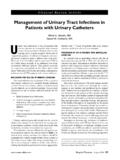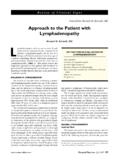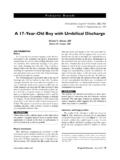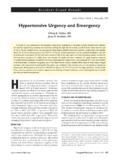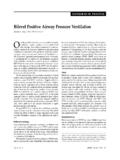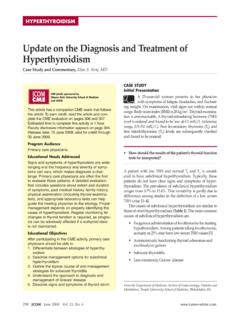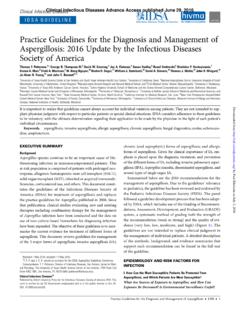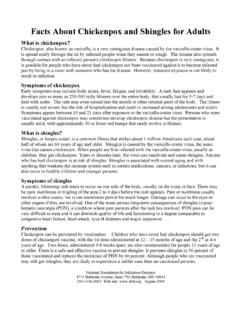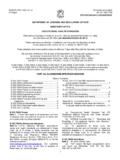Transcription of Electrocardiographic Changes in Infectious Diseases
1 Hospital Physician September 2007 15 Electrocardiography is a valuable, noninvasive graphical representation of the heart s electri-cal activity. Augustus D. Waller, a physiologist from London, published a description of the first human electrocardiogram (ECG) in 1887,1 and since then, the ECG has evolved as a useful tool in diagnosing coronary artery disease, rhythm abnormali-ties, and certain medical conditions. In addition, the ECG can play an important role in the assessment of the severity of illness in a variety of infections and may at times serve as a marker of cardiac involvement or cardiac complications from infection and provide information on The ECG manifestations of infections are oftentimes insignificant but can rep-resent a life-threatening complication, such as para-aortic valve abscess in endocarditis.
2 ECG abnormalities in infections can be caused by multiple factors, includ-ing direct invasion by the microorganism, the effects of the organism s toxin, and electrolyte, metabolic, or autonomic system abnormalities caused by the infec-tion. Unfortunately, the ECG is often overlooked in the evaluation of patients with an Infectious disease. This article highlights Electrocardiographic findings that are associated with bacterial, viral, spirochetal, and parasitic infections and that occur as side effects of an-timicrobial therapy (Table 1). Viral infEctions HiV infectionCardiac involvement is seen predominantly in the advanced stages of HIV-1 infection, and in most cases the etiology of HIV-related cardiac disease is CD4+ T lymphocyte counts of 100 cells/ L or less can be a risk factor for the development of cardiac manifestations in patients with HIV Cardio-vascular abnormalities that can be detected on ECG include sinus tachycardia, left ventricular (LV) systolic dysfunction, right ventricular dilatation,4 dilated car-diomyopathy, pericardial effusion, bacterial endocardi-tis, mitral valve prolapse, myocarditis,5 low-voltage QRS complex, nonspecific ST-segment and T-wave Changes , poor R-wave progression, and prolonged QTc interval.
3 An asymptomatic prolonged QTc interval is associated C l i n i c a l R e v i e w A r t i c l eElectrocardiographic Changes in Infectious DiseasesSandhya Nalmas, MDRangadham Nagarakanti, MD Jihad Slim, MDElfatih Abter, MDEliahu Bishburg, MD TAKE HOME POINTS In patients diagnosed with an Infectious disease, electrocardiography can be used to evaluate for cardiac involvement, provide information on prog-nosis, and assess the effect of treatment. Abnormalities on the electrocardiogram (ECG) of a febrile patient in whom late-stage Lyme disease is suspected can point to the diagnosis; conduction and rhythm disturbances are the most common ECG findings. In a patient with known endocarditis and persistent fever despite appropriate therapy, heart block on repeated ECG may indicate the presence of com-plicated valve abscess.
4 Myocarditis is caused by many Infectious agents and may produce a number of ECG abnormalities: Adams-Stokes syndrome, conduction disturbances, pseudoinfarction pattern, ST-segment and T-wave ab-normalities, and premature ventricular contractions. Physicians should know the QTc interval in a pa-tient to be treated with a quinolone or macrolide as these agents have proarrhythmic Nalmas is a fellow, Dr. Slim is an attending physician, Dr. Abter is the Infectious Diseases Fellowship Program Director, and Dr. Bishburg is Chief; all are at the Division of Infectious Diseases , Newark Beth Israel Medical Center, Newark, NJ. Dr. Nagarakanti is a clinical research fellow, Lankenau Institute for Medical Research, Wynnewood, a l m a s e t a l : E l e c t r o c a r d i o g r a p h i c C h a n g e s : p p.
5 1 5 2 716 Hospital Physician September 2007 increased cardiovascular mortality in HIV infec-tion, and the prevalence of this finding increases as the patient s immune system Arrhythmias are uncommon in both children and adults with HIV infection. The arrhythmias commonly seen are benign and include sinus tachycardia, first-degree heart block, junctional escape rhythm, and premature atrial beats. These arrhythmias rarely prog-ress to supraventricular or ventricular tachycardia,7 second-degree heart block, right bundle branch block, and prolonged QTc, which have high mortality Right ventricular hypertrophy is the most common Electrocardiographic finding in HIV-related pulmo-nary Rubella, or German measles, is an acute exanthem-atous viral infection that occurs mainly in children.
6 The incidence of rubella is low due to use of the vac-cine targeting this virus. The number of rubella cases in United States has dropped since 2001: 23 cases in 2001, 18 in 2002, 7 in 2003, and 9 in The clini-cal manifestations of the disease are fever, adenopathy, and maculopapular rash that begins on the face and moves downward. Myocardial injury is a complication of rubella that is seen rarely due to widespread vacci-nation of children. Abnormal ST-segment and T-wave Changes and axis deviations are often seen on Rubella infection with abnormalities on ECG is associ-ated with increased morbidity. Superior left axis devia-tion in rubella represents either temporary or perma-nent damage to the left bundle branch fascicles and is associated with hemodynamic spirocHEtal infEctionslyme Disease Lyme disease is caused by the spirochete Borrelia burgdorferi, which is spread by the Ixodes scapularis tick (deer tick).
7 Approximately 20,000 cases of Lyme dis-ease are diagnosed each year in the United Lyme disease affects the cardiovascular, musculoskel-etal, and nervous systems. The clinical manifestations are categorized into early and late Diseases . Stage 1 of early disease occurs a few days to 1 month after the tick bite, stage 2 and 3 of early disease occur a few days to 10 to 12 months after the tick bite, and late disease occurs months to years after the tick bite. Stage 1 of early disease manifests as localized infection and an erythematous rash with central clearing at the site of the tick bite, called erythema migrans. Stage 2 of early disease is characterized by multiple annular skin lesions with fatigue, headache, fever, chills, regional lymphadenopathy, and sometimes mild encephalopa-thy.
8 If untreated at this stage, patients can develop neurologic symptoms (eg, meningitis, encephalitis, cranial neuritis, radiculoneuritis, mononeuritis mul-tiplex) and cardiovascular symptoms (eg, fluctuat-ing atrioventricular [AV] blocks, myopericarditis, LV dysfunction, left axis deviation, cardiomegaly, LV Table 1. Common Electrocardiographic Changes in Infectious DiseasesDisease/ ConditionECG Abnormalities HIV infectionSinus tachycardia, LV systolic dysfunction, right ventricular dilatation, low-voltage QRS complex, nonspecific ST-segment and T-wave Changes , poor R-wave progression, and prolonged QTc intervalRubellaAbnormal ST-segment and T-wave Changes and axis deviationsLyme diseaseFirst-degree AV blocks, shorter duration of Q, and deeper S waveLeptospirosisFirst-degree AV heart block and pericarditisChagas diseaseRBBB, left anterior hemiblock, heart blocks TrichinosisTransient nonspecific ventricular repolarization dis-turbance, nonspecific Changes from pericarditisDiphtheria Myocarditis, PR-interval prolongation, T-wave Changes , intraventricular blocks.)
9 And AV conduc-tion blocksTetanusSinus tachycardia, prolonged QT interval, nonspe-cific ST-segment and T-wave Changes , and P-wave changesPertussisSinus node and AV nodal blocksRheumatic feverFirst-degree heart block Invasive strep-tococcal infectionsST-segment and T-wave changesTyphoidMyocarditis, PR-interval prolongation, QTc prolon-gation, ST-segment depression, T-wave inversionPericarditisPR depression, ST-segment elevation, then normal-ization of the ST segment, T-wave inversion, and finally normalization of all changesMyocarditisAdams-Stokes syndrome, conduction disturbances, pseudoinfarction pattern, ST-segment and T-wave Changes , and premature ventricular contractionsEndocarditisSinus tachycardia, low QRS voltage, varying de-grees of heart blocksMycoplasmosisT-wave inversion, bradycardia, prolonged PR inter-val and narrow QRS complexIncreased intra- cranial pressureTall P waves, prominent U waves, inverted U waves, ST-segment and T-wave Changes (eg, depression or elevation), notched T waves, sinus bradycardiaMacrolides, quinolones Prolonged QT intervalAV = atrioventricular; ECG = electrocardiogram; LV = left ventricular; RBBB = right bundle branch block.
10 Hospital Physician September 2007 17N a l m a s e t a l : E l e c t r o c a r d i o g r a p h i c C h a n g e s : p p . 1 5 2 7dysfunction, sinus arrhythmia, sinus bradycardia, ST-segment and T-wave abnormalities, wandering atrial pacemaker, ectopic atrial bradycardia, and ventricular ectopy).14 16 Stage 3 is characterized by intermittent joint pains and swelling primarily in large joints as a re-sult of the immune response to the infection; chronic neurologic Changes are seen in approximately 5% of people with the disease. The incidence of cardiac involvement in Lyme dis-ease is estimated to be 8% in adults; conduction and rhythm disturbances are the most common The cardiovascular manifestations usually occur within the first 21 days of exposure to B.


